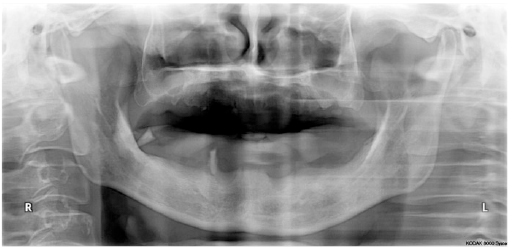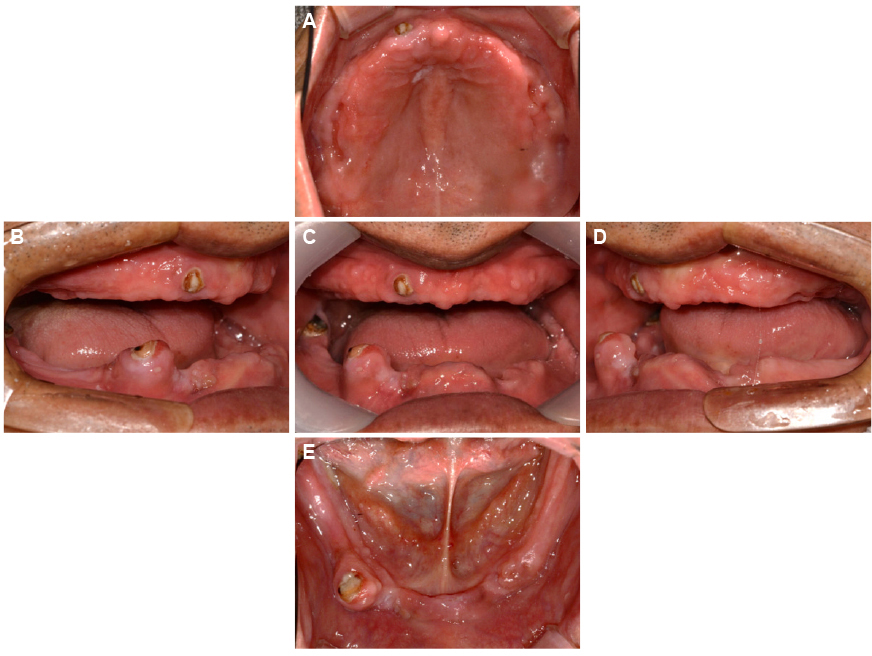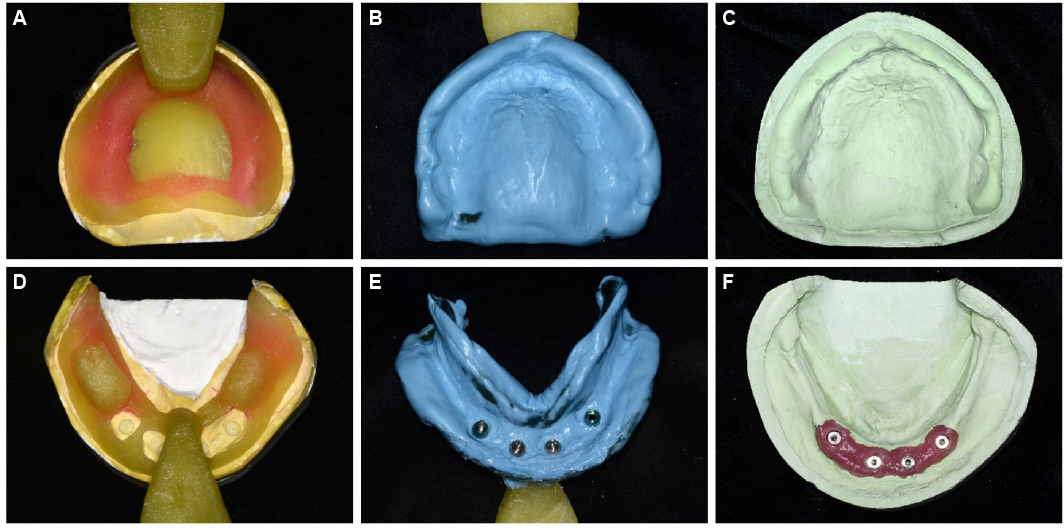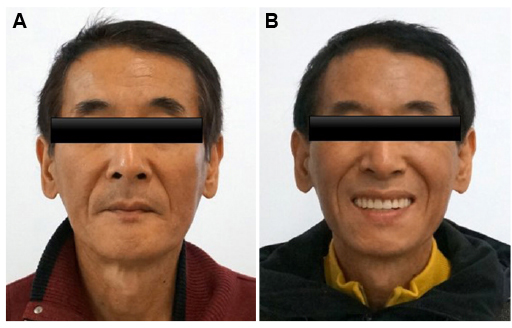J Korean Acad Prosthodont.
2017 Jul;55(3):292-299. 10.4047/jkap.2017.55.3.292.
Rehabilitation using mandibular implant overdenture with CAD/CAM milled bar: A case report
- Affiliations
-
- 1Department of Prosthodontics, School of Dentistry, Chonnam National University, Gwangju, Republic of Korea. yhsdent@chonnam.ac.kr
- KMID: 2387202
- DOI: http://doi.org/10.4047/jkap.2017.55.3.292
Abstract
- Long-term alveolar bone resorption in edentulous patient causes difficulty in denture use. Applying an implant overdenture with 2 to 4 implants to edentulous patient is easily approachable. Moreover, it improves denture stability, support, and retention. Milled bar, the attachment used in implant overdenture, can be used to induce better stability and retention to the supporting structure than conventional bar. It has become convenient to use due to the development of CAD/CAM system which had allowed the simplification of dental techniques. In this case, application of conventional maxillary full denture and mandibular overdenture made of CAD/CAM milled bar with 4 implants showed satisfactory results in the patient who had used upper and lower full dentures for a long time.
Keyword
Figure
Reference
-
1. Cordioli G, Majzoub Z, Castagna S. Mandibular overdentures anchored to single implants: a five-year prospective study. J Prosthet Dent. 1997; 78:159–165.
Article2. Jemt T, Chai J, Harnett J, Heath MR, Hutton JE, Johns RB, McKenna S, McNamara DC, van Steenberghe D, Taylor R, Watson RM, Herrmann I. A 5-year prospective multicenter follow-up report on overdentures supported by osseointegrated implants. Int J Oral Maxillofac Implants. 1996; 11:291–298.3. Shayan N, Ashish C, Mohamad I, Muzafar A. Implant supported overdenture: an alternative to conventional denture- a case report. J Dent Med Sci. 2016; 15:39–42.
Article4. Stoumpis C, Kohal RJ. To splint or not to splint oral implants in the implant-supported overdenture therapy? A systematic literature review. J Oral Rehabil. 2011; 38:857–869.
Article5. Sadowsky SJ. Mandibular implant-retained overdentures: a literature review. J Prosthet Dent. 2001; 86:468–473.
Article6. Burns DR. Mandibular implant overdenture treatment: consensus and controversy. J Prosthodont. 2000; 9:37–46.
Article7. Krennmair G, Krainhöfner M, Piehslinger E. Implant-supported mandibular overdentures retained with a milled bar: a retrospective study. Int J Oral Maxillofac Implants. 2007; 22:987–994.8. Bakke M, Holm B, Gotfredsen K. Masticatory function and patient satisfaction with implant-supported mandibular overdentures: a prospective 5-year study. Int J Prosthodont. 2002; 15:575–581.9. Berretin-Felix G, Nary Filho H, Padovani CR, Trindade AS Junior, Machado WM. Electromyographic evaluation of mastication and swallowing in elderly individuals with mandibular fixed implant-supported prostheses. J Appl Oral Sci. 2008; 16:116–121.
Article10. Carlsson GE, Lindquist LW. Ten-year longitudinal study of masticatory function in edentulous patients treated with fixed complete dentures on osseointegrated implants. Int J Prosthodont. 1994; 7:448–453.11. Spyropoulou PE, Razzoog ME, Duff RE, Chronaios D, Saglik B, Tarrazzi DE. Maxillary implant-supported bar overdenture and mandibular implant-retained fixed denture using CAD/CAM technology and 3-D design software: a clinical report. J Prosthet Dent. 2011; 105:356–362.
Article12. Beuer F, Schweiger J, Edelhoff D. Digital dentistry: an overview of recent developments for CAD/CAM generated restorations. Br Dent J. 2008; 204:505–511.
Article13. Kurtz SM, Devine JN. PEEK biomaterials in trauma, orthopedic, and spinal implants. Biomaterials. 2007; 28:4845–4869.
Article14. Toth JM, Wang M, Estes BT, Scifert JL, Seim HB 3rd, Turner AS. Polyetheretherketone as a biomaterial for spinal applications. Biomaterials. 2006; 27:324–334.
Article15. Stawarczyk B, Beuer F, Wimmer T, Jahn D, Sener B, Roos M, Schmidlin PR. Polyetheretherketone-a suitable material for fixed dental prostheses? J Biomed Mater Res B Appl Biomater. 2013; 101:1209–1216.
Article16. Liebermann A, Wimmer T, Schmidlin PR, Scherer H, Löffler P, Roos M, Stawarczyk B. Physicomechanical characterization of polyetheretherketone and current esthetic dental CAD/CAM polymers after aging in different storage media. J Prosthet Dent. 2016; 115:321–328.
Article
- Full Text Links
- Actions
-
Cited
- CITED
-
- Close
- Share
- Similar articles
-
- Rehabilitation of edentulous maxilla with implant-supported milled bar overdenture using CAD/CAM customized abutment: A case report
- Maxillar implant-retained overdenture using CAD/CAM milled zirconia bar with PEKK sleeve: a case report
- CAD-CAM fabricated Milled-bar and Implant Overdenture after Reconstruction with a Fibular Free Flap: A Clinical Report
- Detachable zirconia prosthesis using Milled bar and ADDTOC attachment in partial edentulous mandible: A case report
- Implant-supported milled bar overdenture with two implant surgical guides











